Cincinnati Mennonite Arts Weekend
Lori Bontrager
"Mennonite Arts Weekend, February" - is it becoming a familiar term? Or better yet, has it become part of the rhythm of your schedule?
Cincinnati Mennonite Fellowship (CMF) has been promoting the arts and the integration of artists in the congregational setting for the past decade. Mennonite artists spur this energetic congregation with their comments and questions, such as "We as artists can try to name where we are now; is this where we want to be? If not, what do we want to do about it?" (Milonica Stahl-Wert)
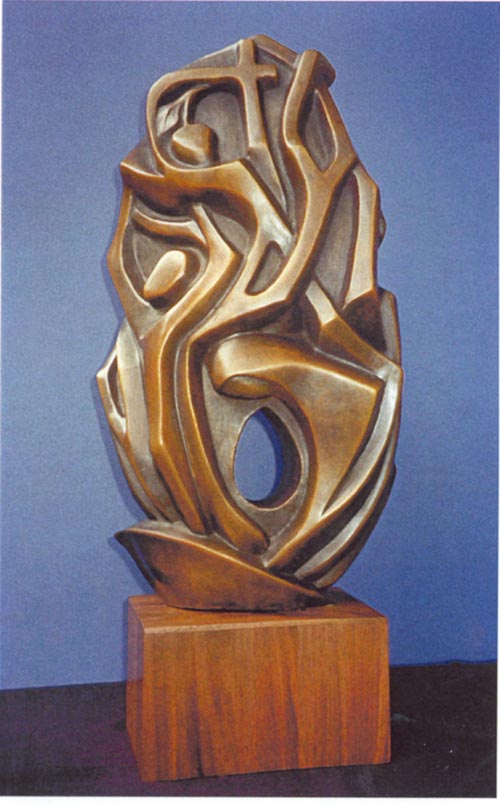 Esther Augsburger, "The Seed Must Die to Live"; bronze sculpture |
The Arts Weekend grew out of a group that had gathered in Normal, IL in 1989 - Mennonite artists simply wanted to "pull together" in some form to help "reclaim their identity/relationship with the church." Phil Clemens was instrumental in beginning this structured communication. "We see a need for the arts in worship. Religion is danced before it is believed. . . . God calls us to participate as we are . . . no matter how we work or play, Jesus is there." A few of the group opted to give specific shape to "an Arts gathering," with impetus from members Cheryl Pannabecker, Hal Hess, Chris Schumacher, Jim Miller, Ed Diller, and Cynthia Stayrook. They saw this as a way to serve the larger Mennonite Church - through the arts. Thus, "Mennonite Arts Weekend" (MAW) was born in 1991. MAW has explored various facets of art in weekend workshops, and it is growing stronger with each biennial gathering.
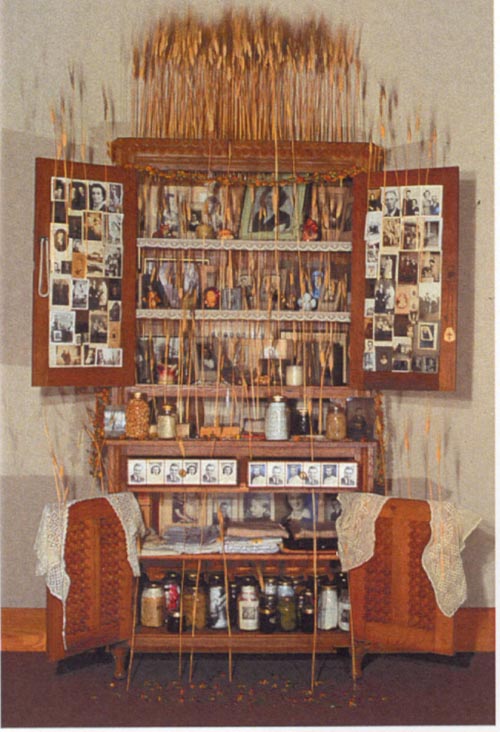 Katherine Bartel, "Invocation"; cabinet with wheat |
Given the history of the (lack of or mis-) use of broader art, these weekends have offered a process to explore, discover, and restore creative expression in our faith communities and in our worship services. At one point, Stan Kaufman commented "I lament . . . all those real gifts from God that didn't get used." But Brad Yoder had observed, "We're told that certain things - big, dangerous things - can't be talked about. And so we've kept a lid on them. But we might find ways to discover and communicate truths - even difficult truths - through the creative arts." This will no doubt prove to be a powerful - and freeing - process for drawing on the richness of God's gifts, especially when we recognize the power of the arts in healing and in celebration.
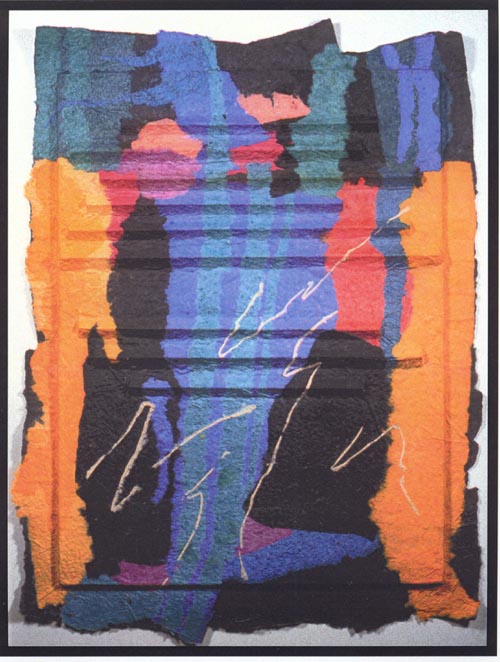 Barbara Fast, "Cranyon"; paper dyed blues & orange |
The vision the group articulates for the MAW is "a weekend to encourage the arts in Mennonite communities, to provide exposure for artists working in different facets of the arts, to provide a setting for interaction and the exchange of ideas, and to bring together practicing Mennonite artists and others of all traditions interested in the arts." They strive to extend their vision, as financial support becomes stronger, to provide scholarships which would serve to encourage young artists to stay connected with the church through their gifts.
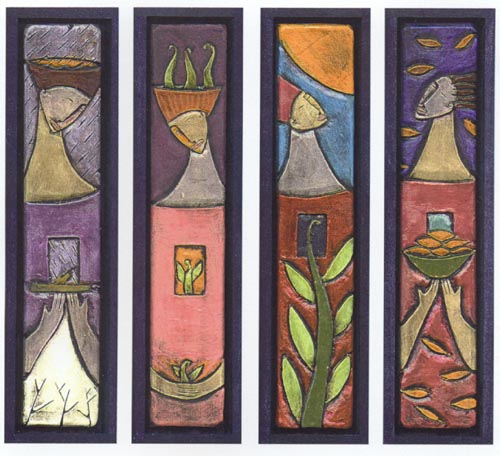 Sandra Zeiset Richardson, "The Four Seasons"; set of 4 paintings |
What distinguishes these events as unique? Jeff Gundy noticed an obvious difference: it's "a Mennonite gathering where theology is done by poets rather than theologians." Hal Hess reminds us that MAW is "sponsored by congregations as opposed to academics." This is meant to pave a real path for drawing artists back into congregations (plus having a place for the artists in the faith community). Through this, "MAW is willing to raise the difficult questions about the relationships between art and worship." (Rebecca Slough)
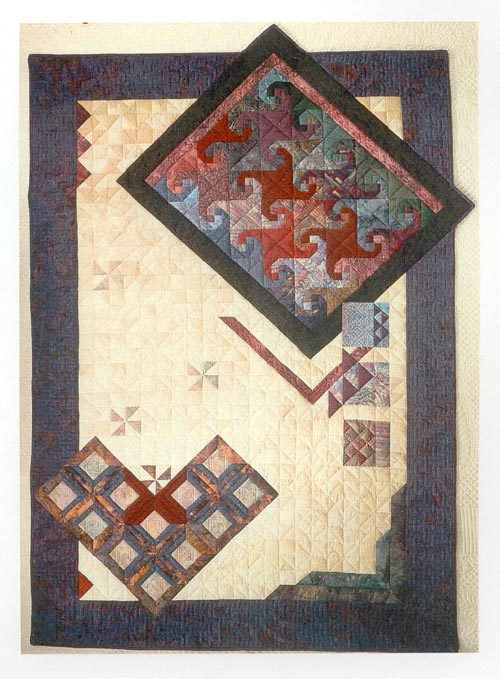 Shirley Shenk, "Indian Interlock"; quilt |
Over the years, there has been a long line of qualified artists participating - some are "legends" to MAW, some newly joined. The themes have covered art in every day, the healing arts, the "body" in art and spirituality, and present day expression. This year's focus will strengthen the "building of bridges between artists and their congregations." The list of presenters and performers through the MAWs is extensive, but an interesting one, well worth including here (at the risk of forgetting someone, with full apologies): Esther Augsburger, Katherine Bartel, Dorothy Bowman, Doug Brunk, Phil Clemens, Dirk Eitzen, Dina Pannabecker Evans, William Everett, Barbara Fast, Chad Friesen, Loren Friesen, John Glick, Barbra Graber, Jeff Gundy, "Harder to Dew" (Tom, Lois Harder, and Duane Gundy), Jon Helmuth, Jen Helmuth-Shenk, Michelle Hershberger, Phil Hershberger, Dan Hess, David Hiebert, Raylene Hinz-Penner, Marilyn Houser-Hamm, Jep Hostetler, Franz Jantzen, Jean Janzen, Janeen Bertsche Johnson, Julia Kasdorf, Stan Kaufman, Juanita Kauffman, Merrill Krabill, Jerry Lapp, Joanne Lehman, Greg Luginbuhl, Diane Mankin, Evie Yoder Miller, Linda Schlabach Miller, J. Harold Moyer, Julie Musselmann, Ken Nafziger, Chuck Neufeld, Mary Oyer, Cheryl Pannabecker, Margaret Bachman Reid, Carla Reimer, Sandra Zeiset Richardson, Mahlon Schmucker, Shirley Shenk, Sonya Siebert, Sydney Simpson, Rebecca Slough, Milonica Stahl-Wert, Steve and Cyd Stayrook, "Ted and Lee" (Ted Swartz and Lee Eshleman), Peter Terry, Mary Mitchell Trejo, Roy Umble, Lucia Unrau, Carolyn Urich, David Waltner-Toews, Brent Weaver, Carol Weaver, Herb Weaver, Esther Wiens, Gene Wiggins, Dallas Wiebe, Douglas Witmer, David Wright, Brad Yoder, Cynthia Yoder, and Roy Yoder. Larger groups contributing were Bluffton College Camerata Choir (Debra Lenssen), Goshen College Chamber Choir (Doyle Preheim), Bluffton College Jazz Ensemble (Adam Schattschneider), Eastern Mennonite University Chamber Choir (Ken Nafziger), Hesston College Bel Canto Singers (Jake Rittenhouse), CMF choir (Warren Friesen), Cleveland's Lee Heights Community Church Gospel Choir (Craig Burkey), and drama groups from Goshen College (Roy Umble) and Hesston College (Mariann Martin). Together, they represent all art forms, including dance, body/word art, music, conducting, visual art (sculpting, painting, photography), drama, writing, storytelling, even magic. They've come from Oregon, California, Ontario, New York, Midwest - even the MAW participants span the country. This is no "local Joe's" event!
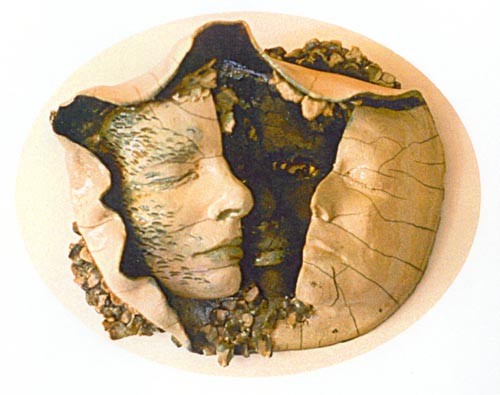 Carolyn Ulrich, "Search for Identity"; two faces in earthenware |
Some "old standards" have emerged to shape each MAW: a Friday evening coffeehouse with entertainment, Saturday workshops on particular art forms, a hymn sing, discussion forum, Saturday evening concert, and then the expression of the various arts culminating in the Sunday morning worship. Attention has been given to the youth as well through the compilation of works they submitted, which are then presented during the weekend.
The 2002 MAW will follow much of the above, as well as include a tribute to Mary Oyer, musician (simply put). The main forum will address questions to artists as well as to pastors: "What specific contribution would your artwork make to your congregation's life? As a person of faith, what do you hope people of your congregation would experience through your work? What would people need to do, learn, or know to enter into your artwork more fully? What problems are raised for you as pastor if your congregation were to use more openly any of the artwork you saw today? What particular strengths does your congregation have to offer to support and nurture the work of what you heard/saw today?" The forum's hour session will merely be able to start this conversation! Naturally, much sharing is done well beyond any of these session constraints.
All attendees - participants as well as presenters - seem to benefit greatly from this venue. "True art, we were saying to each other, is a gift from God, His image at work in ours, seeking integration of our selves, with Him, and to humanity around us. And in that joining of what was intended to be one and whole, we work against destructive forces that divide." (Jean Janzen, poet)
Art - how could we have neglected its powerful capacity to draw us
closer to our God and to each other? My deep gratitude goes to those
whose energies have well begun rediscovering this in the Mennonite
Church.
The theme of Mennonite Arts Weekend 2002 is "Building Bridges: Artists and the Congregation." The dates are Feb. 1-3, 2002. Featured presenters include:
- Tom and Lois Harder with Duane Gundy, musicians
- Marilyn Houser Hamm, musician
- Michele Hershberger, playwright
- Phil Hershberger, artist
- David Hiebert, publisher
- Jep Hostetler, magician
- Linda Schlabaugh Miller and John Glick, dancers
- Ken Nafziger, musician
- Rebecca Slough, musician
- Lucia Unrau, pianist
- David Wright, poet
- Roy Yoder, potter
For further information contact Hal Hess or Christine Schumacher.
 December 2001
vol. 56 no. 4
Back to Table of Contents
December 2001
vol. 56 no. 4
Back to Table of Contents